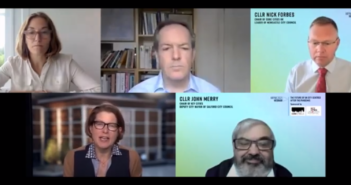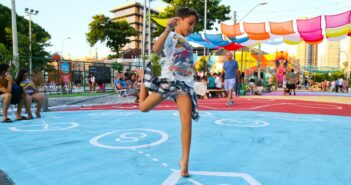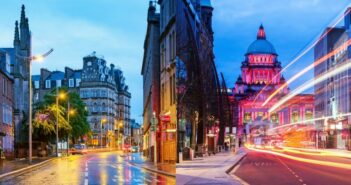A framework without constraints
Brand leadership is not a grassroots democratic process, but is based on the free / standing leg principle. The resulting activities are based on careful analysis of the facts. Once the basic guidelines have been developed, calculated and carefully controlled deviations from these guidelines offer a mature and self-confident access to the theme of brand leadership in accordance with the motto: you can break any rule as long as you know it. To this extent, Vienna does not view the resulting brand process as a constraint, but as a framework within the confines of which the occasional “transgression” is admissible.
Without such transgressions, one rapidly ends up in an international branding no man’s land, depending on which branding philosophy (“guru”) the city places its faith in. We are all green, modern, creative and cool. So far, so mistakable. However, the uncoolest thing of all is to claim that one is green, modern, creative and cool. All this can be proved entirely by facts or the manner in which one does things. The observer’s emotions are then involuntarily aroused.
However, this presupposes a frank and critical attitude towards one’s own strengths and weaknesses. As a city, it does help to be the best in at least one area (and this applies to Vienna in many respects!). But a city and its marketers should at least be familiar with their weaknesses, too, and know how to deal with them. There is nothing more dreary than ill-considered clichés presented in a mistakable way – both for the general public and for oneself.
Vienna’s standing leg: brand analysis
Brand image can only be controlled to a limited extent, and is nothing more or less than a prejudice, ideally a positive one. If many people share the same prejudice about a thing – such as a destination, for instance – then we can already refer to a “brand”. However, as the individuals responsible for advertising for the destination Vienna, there are only very few instances in which we can control the factors leading to image building – and in point of fact this never works with a large metropolis. And this is a good thing, too, since it is precisely this uncontrollability that gives a city its charm.
However what we can certainly do is to know the image of our destination and the concrete factors underlying it; in other words, the characteristics of the destination that produce a correspondingly positive resonance. The important thing is to focus on these in one’s communication. This is more productive than simply racking one’s brains over a new logo, putting out a new image brochure, or pumping financial resources into a new advertising campaign.
In 2009 the Vienna Tourist Board conducted an extensive market analysis in order to establish what the destination brand Vienna stands for internationally, what its success factors are for tourism, and the concrete measures that should be taken to successfully position the destination Vienna. As part of a new marketing strategy, this international study did not involve looking at the question of “old, traditional Vienna” versus “new, modern Vienna”, but focused instead on understanding the destination in its entirety, interpreting it as a brand, and defining the most important elements of its identity. The results of this analysis provided the basis for Vienna’s worldwide tourism advertising line and for marketing activities designed to reflect the destination optimally in tune with the times.
Vienna’s brand modules
A total of 11,000 guests and potential guests in nine different countries were asked about their reasons for taking a Vienna vacation – in other words, about their positive prejudices. The result can be condensed into a total of five brand images (also referred to internally as brand modules):
• Imperial heritage
• Profusion of music and culture
• Viennese “savoir vivre”
• Functional efficiency
• Balance of urban and green areas
Vienna is a city with an impressive imperial heritage. Especially in the historic city centre, this is what characterizes the streetscape. There are several factors determining this image behind the first brand module: the brand drivers. For example, Schönbrunn Palace, the Ringstrasse boulevard and the Imperial Palace are characteristics belonging to the “imperial Vienna” brand module. Vienna is also perceived as a world capital of music and culture. The underlying factors here include the variety of classical concerts, three opera houses, world-famous theatres, and the Vienna Boys’ Choir. However, the city of Vienna also stands for a unique “lifestyle”: the culture of enjoyment and Viennese “savoir vivre”. This image is underpinned above all by a unique and very special coffee-house culture, the city’s viniculture with its heuriger wine taverns, and by Viennese cuisine – from wiener schnitzel to Sachertorte and gugelhupf. Moreover Vienna is regarded as a very clean, safe, walkable, friendly and clearly arranged city – in other words, as a smoothly functioning city, which is an important factor in city travel for tourists the world over. And finally, Vienna has a very high proportion of parks and gardens – the fifth brand module. Parks, gardens, recreational areas such as the Danube Island and the Prater and the vineyards give the city a harmonious balance of urban and green areas.
From marketing analysis to advertising concept: VIENNA – NOW OR NEVER!
Thanks to our brand analysis, we also know both the factors that create a positive Vienna image, and the weighting of the individual modules and brand drivers. This makes the Vienna brand “manageable” – and hence we were able to clearly define the commission for our advertising agency, with the following result: the newly developed logo (the design of which evolved from the previous one, but stripped down and in a more modern style) and the “VIENNA” lettering together with the new claim and web address are placed inside a square, though the red typeface on a white background has been retained. As far as the claim is concerned, we came to the realization that the city’s manifold attractions and activities cannot be reduced to a single statement. This would inevitably be abstract and ineffective. Instead, with the new claim the basic strategic challenge is to transform Vienna from a “once in a lifetime” destination to a “now and forever” destination, condensed in a saying that is common in languages around the world and that every toddler learns is a call to action: “NOW OR NEVER!” In order to achieve greater differentiation and recognizability, we also developed a new imagery incorporating elements such as image detail, perspective, light, coloring, choice of theme, etc., which at the same time presents Vienna as a modern, cosmopolitan, international and living metropolis. The images show exciting perspectives with a modern photographic aesthetic that does not look artificial.
The persuasion strategy
We were clear about the development process for the Vienna brand: since each brand component and the communication goals formulated for it represents a claim that has not been verified, some persuasion is also needed. Proof is needed to persuade the public that our claims are true. Our strategy is designed to cause consumers to think they have come up with the desired ideas independently and of their own accord. A variety of different strategies are used to this end. Side-by-side evidence is one such persuasion strategy deployed in Vienna’s new advertising line. Consumers can form their own opinions based on an objective, observable comparison: they can compare their current situation with what is available in Vienna at the same time. Around the globe, people in everyday situations can see what they could be experiencing in Vienna “at this very moment”. A comparison of these two situations is the structural element that is rounded out by the claim: “VIENNA – NOW OR NEVER!” It is therefore a comparison of moments: “At this very moment, you are missing…” The campaign incorporates a persuasion strategy built on facts. Because it is infinitely variable, the strategy behind it can be used and extended in many different ways. At this very moment, you can experience something more exciting in Vienna than you can at home: a visit to Schönbrunn Palace, to the Vienna State Opera or a festival, a glass of Viennese wine at a heuriger wine tavern, a slice of guglhupf at a coffee-house, etc.
At b2b.wien.info/en/media/pictures, you can form an impression of the way in which Vienna advertises and attempts to persuade visitors to come here. I hope that you, too, will come to the conclusion that your (next) visit to Vienna had better be “NOW OR NEVER!”
A contribution by Norbert Kettner, Director of the Vienna Tourist Board
Further information:
B2C website: www.wien.info
B2B website: b2b.wien.info
Vienna brand: b2b.wien.info/en/brand
Top image credit : Photobank gallery



